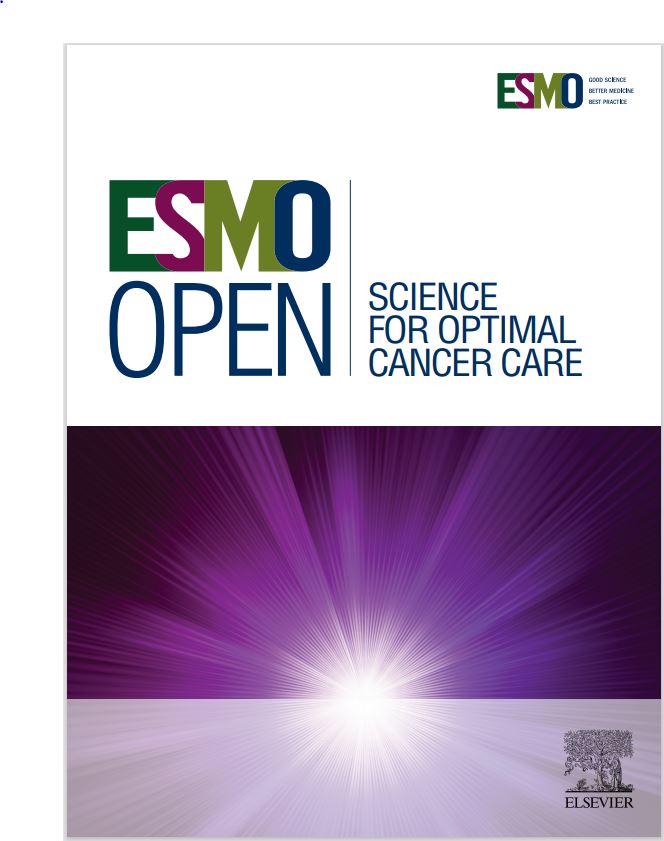Artificial intelligence defines spatial patterns of tumor-infiltrating lymphocytes highly associated with outcome – a pan-GI cancer study
IF 8.3
2区 医学
Q1 ONCOLOGY
引用次数: 0
Abstract
Background
Gastrointestinal (GI) cancers (including esophagus, stomach, colon, rectum, pancreas and liver) account for more than one-quarter of all cancer diagnoses and 35% of cancer-related fatalities worldwide. Quantification of tumor-infiltrating lymphocytes (TILs) is a known cancer prognostic marker. In this study, we used computer vision and machine learning [artificial intelligence (AI)] approaches to evaluate the prognostic significance of computational pathology features relating to spatial arrangement and diversity in the appearance of TILs and cancer nuclei across five different types of GI cancers: colon, stomach, pancreas, and rectum adenocarcinoma and liver hepatocellular carcinoma.
Patients and methods
The study comprises >1700 patients from four different sites. Pathomic features (2236) were extracted from hematoxylin–eosin stained whole slide images and the top 9 features were selected by Least Absolute Shrinkage and Selection Operator (LASSO) Cox model. The top prognostic features identified were related to the spatial relationships between TILs and the closest cancer nuclei and tumor nuclei shape and texture features captured within local cellular clusters.
Results
Our trained model identified that ‘low-risk’ patients have significantly better overall survival than those identified as ‘high risk’ with a hazard ratio (HR) of 2.28 [95% confidence interval (CI) 1.32-3.93, P = 0.0032] in liver hepatocellular carcinoma; an HR of 2.79 (95% CI 1.66-4.68, P = 0.0001) in pancreatic adenocarcinoma; an HR of 5.85 (95% CI 2.53-15.5, P = 0.0002) in rectal adenocarcinoma; an HR of 1.81 (95% CI 1.07-3.07, P = 0.0268) in gastric adenocarcinoma. Across three different external validation sets of colorectal cancer (CRC) patients, our model yielded an HR of 2.32 (95% CI 1.67-3.23, P < 0.0001) in The Cancer Genome Atlas-Colon Adenocarcinoma (TCGA-COAD), an HR of 2.32 (95% CI 1.67-3.23, P < 0.0001) in Prostate, Lung, Colorectal, and Ovarian Cancer Screening Trial (PLCO)-COAD, and an HR of 3.38 (95% CI 1.99-5.71, P < 0.0001) in the Emory dataset. Multivariable survival analysis showed that our trained model was prognostic independent of stage, age, race, and sex.
Conclusions
Our findings suggest that the spatial relationships of TILs and cancer nuclei are prognostic of survival across multiple GI cancer types.
人工智能定义了肿瘤浸润淋巴细胞与预后高度相关的空间模式——一项泛胃肠道癌症研究。
背景:胃肠道(GI)癌症(包括食道癌、胃癌、结肠癌、直肠癌、胰腺癌和肝癌)占全球所有癌症诊断的四分之一以上,占癌症相关死亡人数的35%。肿瘤浸润淋巴细胞(til)的定量是一种已知的癌症预后指标。在这项研究中,我们使用计算机视觉和机器学习[人工智能(AI)]方法来评估与五种不同类型的胃肠道癌症(结肠癌、胃癌、胰腺癌、直肠腺癌和肝癌)中TILs和癌核外观的空间排列和多样性相关的计算病理学特征的预后意义。患者和方法:该研究包括来自四个不同部位的bb1700名患者。从苏木精-伊红染色的整张切片图像中提取病变特征(2236个),采用最小绝对收缩和选择算子(LASSO) Cox模型选择前9个特征。确定的最重要预后特征与til与最近的癌核之间的空间关系以及局部细胞簇中捕获的肿瘤核形状和纹理特征有关。结果:我们的训练模型发现,肝癌“低风险”患者的总生存率明显高于“高风险”患者,风险比(HR)为2.28[95%可信区间(CI) 1.32-3.93, P = 0.0032];胰腺腺癌的风险比为2.79 (95% CI 1.66-4.68, P = 0.0001);直肠腺癌的风险比为5.85 (95% CI 2.53-15.5, P = 0.0002);胃腺癌的风险比为1.81 (95% CI 1.07-3.07, P = 0.0268)。在结直肠癌(CRC)患者的三个不同的外部验证集中,我们的模型在癌症基因组图谱-结肠腺癌(TCGA-COAD)中产生的HR为2.32 (95% CI 1.67-3.23, P < 0.0001),在前列腺、肺、结直肠癌和卵巢癌筛查试验(PLCO)-COAD中产生的HR为2.32 (95% CI 1.67-3.23, P < 0.0001),在Emory数据集中产生的HR为3.38 (95% CI 1.99-5.71, P < 0.0001)。多变量生存分析表明,我们训练的模型与分期、年龄、种族和性别无关。结论:我们的研究结果表明,TILs和癌核的空间关系是多种胃肠道癌症类型的预后。
本文章由计算机程序翻译,如有差异,请以英文原文为准。
求助全文
约1分钟内获得全文
求助全文
来源期刊

ESMO Open
Medicine-Oncology
CiteScore
11.70
自引率
2.70%
发文量
255
审稿时长
10 weeks
期刊介绍:
ESMO Open is the online-only, open access journal of the European Society for Medical Oncology (ESMO). It is a peer-reviewed publication dedicated to sharing high-quality medical research and educational materials from various fields of oncology. The journal specifically focuses on showcasing innovative clinical and translational cancer research.
ESMO Open aims to publish a wide range of research articles covering all aspects of oncology, including experimental studies, translational research, diagnostic advancements, and therapeutic approaches. The content of the journal includes original research articles, insightful reviews, thought-provoking editorials, and correspondence. Moreover, the journal warmly welcomes the submission of phase I trials and meta-analyses. It also showcases reviews from significant ESMO conferences and meetings, as well as publishes important position statements on behalf of ESMO.
Overall, ESMO Open offers a platform for scientists, clinicians, and researchers in the field of oncology to share their valuable insights and contribute to advancing the understanding and treatment of cancer. The journal serves as a source of up-to-date information and fosters collaboration within the oncology community.
 求助内容:
求助内容: 应助结果提醒方式:
应助结果提醒方式:


